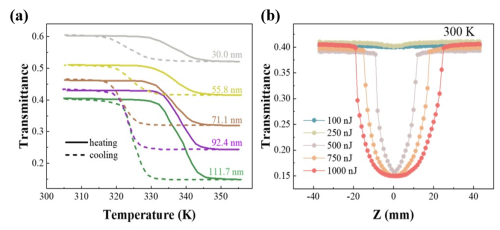Researchers in Shanghai Institute of Optics and Fine Mechanics (SIOM) of the Chinese Academy of Sciences (CAS), carried out systematic investigation on the femtosecond laser-induced phase transition in vanadium dioxide (VO2) films. The related research results have been published in Optics Express on December 19, 2022.
Semiconductor-metal phase transitions in metal oxides are of great interest due to their scientific significance in condensed matter sciences and their possibilities in a variety of applications. VO2 is one of the most representative phase transition materials which undergoes a reversible transition from a low-temperature semiconducting phase to a high-temperature metallic phase. Laser is one important stimulus to inspire the semiconductor-metal phase transition of VO2 as laser is playing an increasingly important role in almost every field of our daily life. It is of high importance and necessity to study the optical properties and clarify the mechanism of laser-induced phase transition in VO2 which will be helpful to extend its application.
In this work, a series of VO2 films were prepared with different thicknesses using magnetron sputtering system, which undergo a phase transition from 330 K to 348 K. The optical properties of these samples during the phase transition were investigated using a home-build variable temperature Z-scan setup with a 380 fs-pulsed laser at 1040 nm.
The experimental results indicate that fs laser-induced changes in the optical properties of VO2 exhibited two different mechanisms, nonlinear absorption and phase transition, at different repetition frequencies. The change in transmittance is caused by the nonlinear absorption of the semiconductor phase at laser repetition frequencies below 10 kHz.
Whereas, "thermogenic echo" lines are generated under laser excitation at repetition frequencies of 50 kHz and higher, indicating that the phase transition is caused by thermal accumulation, and the thermal effect is more obvious as the laser repetition frequency increases. In this case, the sample undergoes a semiconductor-to-metal phase transition, while the nonlinear optical properties change from two-photon absorption to saturation absorption.
The study of the driving properties related to the VO2 phase transition mechanism will be beneficial for the further development of phase change materials in ultrafast all-photonic devices.

Figure 1. (a) Temperature-dependent transmittance at 1040 nm. Solid and dashed lines represent the heating and cooling processes, respectively. (d) Variable energy Z-scan results of the VO2 film obtained at 300 K. (Image by SIOM)
Article website:
https://doi.org/10.1364/OE.477910
Contact:
WU Xiufeng
General Administrative Office
Shanghai Institute of Optics and Fine Mechanics, CAS
Email: xfwu@siom.ac.cn
Web: http://english.siom.cas.cn/